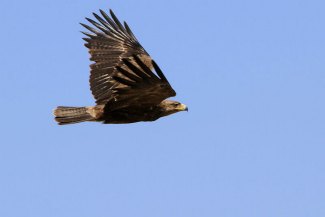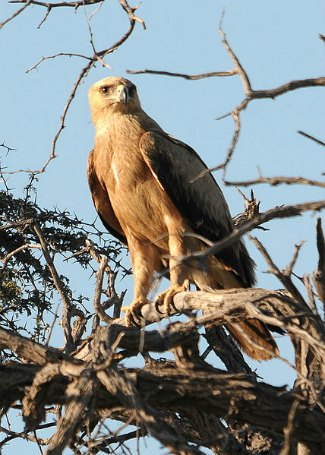Tawny Eagle - Aquila rapax
By Valentina Storti, CC-BY-2.0, via Wikimedia Commons
Family: Accipitridae
Genus: Aquila
Species: A. rapax
Subspecies: A. r. belisarius, A. r. rapax, A. r. vindhiana (Indian Tawny Eagle)
Tawny Eagles are medium-sized to large raptors that live in Asia and Africa. They were formerly classified as part of the same species as Aquila nipalensis (Steppe Eagle), but are now considered a distinct species. They form a clade with A. adalberti (Spanish Imperial Eagle), A. heliaca (Eastern Imperial Eagle), and A. nipalensis.
Physical Description:
There are several morph forms of Tawny Eagles, along with intermediate plumages, subspecies, and individual variations. Dark morphs are dark brown, gray-brown, or brown-black with little contrast in plumage except for a darker tail, flight feathers, and "eyebrows". Pale morphs have more contrast, with rufous, buff, or light brown upperparts, a pale body, and dark flight feathers and tail. Their tails are gray or barred with seven dark bands and the head is streaked with brown. Intermediate adults are brown or rufous-brown with rufous streaking along the mantle and wing-coverts and the breast and flanks are heavily streaked. In all forms, eyes are yellow to light brown and the cere and feet are yellow. The wings are broad and square in shape, the tail is short, and the legs are feathered.
Subspecies A. r. belisarius is larger than the nominate A. r. rapax, has less rufous in its markings, and the pale morph is darker. Subspecies A. r. vindhiana is the smallest of the three and darker in coloring, sometimes with no rufous plumage at all, and the pale morph is grayer.
By Brian Ralphs, CC-BY-2.0, via Wikimedia Commons
Due to all these variations, Tawny Eagles may be confused with Aquila nipalensis (Steppe Eagle), Aquila clanga (Greater Spotted Eagle), Aquila pomarina (Lesser Spotted Eagle), Aquila wahlbergi (Wahlberg’s Eagle), Ictinaetus malayensis (Black Eagle), and Aquila heliaca (Eastern Imperial Eagle). However, A. nipalensis has a longer gape flange, longer and narrower wings, and sharper barring than A. rapax; A. clanga is darker, with shorter and broader wings; A. pomarina is smaller and has a white U above the tail; A. wahlbergi is smaller and has a longer tail and wings; I. malayensis is darker with a longer barred tail; and A. heliaca is bigger with a longer tail.
Dark morph juveniles are entirely rufous to rufous-brown, except for pale-tipped greater wing coverts and a gray barred tail with a light-colored tip. The lower back and uppertail-coverts are cream-colored. Pale morph juveniles are similar to dark morphs, and the eyes of both forms are dark brown. Juveniles reach full adult plumage after five years.
Tawny Eagles are relatively quiet. Their calls have been described as "kowk kowk, kau kau, kiok kiok", "kekeke", "kra", and a shrill "shreep shreep". They are also capable of emitting a loud scream.
Size:
Length: 60-72 cm
Wingspan: 159-183 cm
Weight: A. r. rapax: Male: 1.6-2.0 kg. Female: 1.6-2.4 kg. A. r. belisarius: Male: 2.0 kg.
Female: 1.9-2.5 kg.
Habitat and Distribution:
They live in a range of habitats and are most often found along open wooded savannah and steppe, from 0-3,000 meters above sea level. They avoid deserts and dense woodland.
Tawny Eagles are found in three distinct populations. One is in Asia, encompassing southeast Iran, Pakistan, northwest India, southern Nepal, and western Myanmar. The second population includes much of western Africa in addition to Chad, Sudan, Ethiopia, Somalia, and the southwestern Arabian Peninsula. The third covers sub-Saharan Africa, from Namibia and Botswana to northern South Africa, Lesotho, and Swaziland. Adults are irruptive or local migrants and juveniles disperse from breeding areas, although A. r. belisarius migrates to damp woodland in October-November and returns to its northern range in April. There are an estimated 100,000 individuals over a range of 237,369 km².
Diet and Hunting:
They eat a range of prey, including mammals, birds, reptiles, insects, amphibians, fish, and carrion, usually weighing from 126 g to 2.0 kg. In Kenya, they will often hunt francolins, hares, and bustards, and will even go after Madoqua kirkii (Kirk’s dikdik) which can weigh more than twice that of a Tawny Eagle.
By Stig Nygaard (www.rockland.dk), CC-BY-2.0, via Wikimedia Commons
Most of their prey is taken on the ground, but they sometimes kill birds up to the size of flamingos in flight. They hunt with short dives and swoops, sometimes pouncing down from a perch. They are also kleptoparasites, stealing food from birds such as raptors, storks, and ground hornbills by pursuing the other bird until it is forced to land or drop its prey. Tawny Eagles are also known to eat with vultures at carcasses, and they have been recorded scavenging refuse within, and close to, villages and slaughterhouses.
Reproduction:
Breeding displays consist of high circling, soaring, dives, and swoops done by the male around the female, along with sky dances. The breeding season is from March-August in northern and northeast Africa, October-June in western Africa, year-round in Kenya though peaking in May-November, April-January in central and southern Africa, and November-August in Asia. Pairs are monogamous.
The nest is made out of sticks and occasionally animal bones, and is usually 1.0-1.3 m across and 30 cm deep. It is placed up to 30 m, most often between 6-15 m, above the ground at the top of an isolated tree and lined with grass, leaves, and fur. 1-2, usually 2 eggs are laid and incubated for 39-45 days. Most incubation is done by the female, though the male will sometimes help. Cainism, also known as siblicide, is common, so often only one chick will survive. Fledging takes 76-75 days and the young may remain close the nest until the next breeding season. They reach sexual maturity after 3-4 years.
By Arpingstone, Public domain, via Wikimedia Commons
Conservation:
Tawny Eagles are widespread in northern sub-Saharan Africa, northeastern Africa, and the Indian subcontinent, but in southern Africa, the population has declined due to poisoning, shooting, and drowning in reservoirs. They are also killed by vehicles when they scavenge road kill. Despite such threats, they are currently listed as Least Concern by BirdLife International.
Taxonomy:
Aquila rapax was formerly considered to be part of the same species as Aquila nipalensis (Steppe Eagle), but based morphological, ecological, and behavioral differences the two have been separated. Furthermore, molecular sequencing indicated that the two are not even sister species. However, A. rapax does form a clade with A. adalberti (Spanish Imperial Eagle), A. heliaca (Eastern Imperial Eagle), and A. nipalensis.
Subspecies:
There are three subspecies: A. r. belisarius lives from western Africa to Ethiopia, the southwest Arabian Peninsula, and central Kenya; A. r. rapax lives from southern Democratic Republic of the Congo to northern Kenya and from Angola to Namibia; and A. r. vindhiana lives from southeast Iran to the Indian subcontinent and Myanmar.
Other Names:
Eurasian Tawny Eagle, Indian Tawny Eagle, Roofarend (Afrikaans), Orel okrový (Czech), Rovørn (Danish), Savannearend (Dutch), Savannikotka (Finnish), Aigle ravissuer (French), Savannenadler (German), Pusztai sas (Hungarian), Hræörn (Icelandic), Aquila rapace (Italian), Sameiroinuwashi (Japanese), Savanneørn (Norwegian), Orzel sawannowy (Polish), Águila Rapaz (Spanish), Tai Msasi (Swahili), Savannörn (Swedish), Ghama (Tsonga), Ntsu (Tswana).
Video of a Tawny Eagle:
References:
Westphal, J. 2007. "Aquila rapax" (On-line), Animal Diversity Web. Accessed April 07, 2012 at
http://animaldiversity.ummz.umich.edu/site/accounts/information/Aquila_rapax.html
http://www.arkive.org/tawny-eagle/aquila-rapax/
http://avibase.bsc-eoc.org/species.jsp?avibaseid=F6D547B28875698E
http://www.biodiversityexplorer.org/birds/accipitridae/aquila_rapax.htm
BirdLife International (2012) Species factsheet:Aquila rapax. Downloaded from http://www.birdlife.org on 07/04/2012.
Global Raptor Information Network. 2012. Species account: Tawny Eagle Aquila rapax. Downloaded from
http://www.globalraptors.org on 7 Apr. 2012
http://ibc.lynxeds.com/species/tawny-eagle-aquila-rapax
http://www.kenyabirds.org.uk/teagle.htm
BirdLife International 2009. Aquila rapax. In: IUCN 2011. IUCN Red List of Threatened Species. Version 2011.2.
www.iucnredlist.org. Downloaded on 07 April 2012.
http://www.nnf.org.na/RAPTORS/raptors_pges/tawnyeagle.htm
http://www.planetofbirds.com/accipitriformes-accipitridae-tawny-eagle-aquila-rapax
Ferguson-Lees, James, and Christie, David A. Raptors of the World. Houghton Mifflin Company, 2001.



